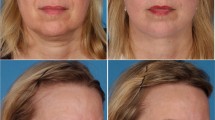Abstract
Background
A conventional superficial musculoaponeurotic system (SMAS) face-lift is well established because it allows the skin envelope to be rotated in a bit more lateral direction than the cephalad redirection of the SMAS flap. This ensures an individualization of the treatment plan according to the needs of the patient and avoids a postoperative stretched look. However, this technique has some limitations with respect to its long-term effects on the sagging tissue, inadequate lifting of the malar fat pad, and flattening of the nasolabial fold.
Methods
The procedure described by the authors consisted of a modified approach to conventional SMAS flap dissection for 327 patients with facial aging signs undergoing a face-lift. A pointing tongue-shaped flap of zygomaticotemporal fascia was dissected and preserved in the posterior half of the upper edge of the SMAS flap and anchored to the deep temporal fascia, enhancing the vertical support of the facial soft tissues. Outcomes were determined by case notes, clinical review, and a questionnaire.
Results
The study investigated 327 consecutive modified SMAS face-lifting procedures. Few complications were observed. Only two patients experienced small hematomas needing evacuation. Some patients reported bearable pain in the temporal region and tension during mouth opening. Temporary weakness in the branches of the facial nerve experienced by two patients resolved completely within some months. Two patients presented with dehiscence of the scar, and one patient experienced punctual retroauricular skin necrosis, which healed uneventfully with conservative treatment. Two patients reported that the knot in the temporal region was palpable through the skin. One patient experienced retroauricular infection. Only two patients required additional procedures. One mild hypertrophic scar responding to steroid injection over the mastoid area was observed in the entire series. With the reported technique, the authors achieved pleasing, natural, durable results with minimal morbidity and an overall complication rate of 3.9%. All the patients were sent a satisfaction questionnaire or contacted for a telephone interview. A total of 235 patients replied. The patients reported high levels of satisfaction after treatment.
Conclusions
The authors believe that the rhytidectomy technique described in this report has several beneficial attributes. High vertical elevation of the SMAS flap delivers a long-lasting benefit and addresses the problem of neck laxity and platysma redundancy, leading to a correction of the neck contouring and jowls. Nasolabial folds appear to be smoothed, and malar flattening is restored by imbrications of the SMAS flap over the cut edge in the malar prominence. This investigation demonstrates that the rhytidectomy technique is safe and produces highly predictable results.








Similar content being viewed by others
References
Skoog T (1974) Plastic surgery: new methods. WB Saunders, Philadelphia
Mitz V, Peyronie M (1976) The superficial musculoaponeurotic system (SMAS) in the parotid and cheek area. Plast Reconstr Surg 58:80–88
Ivy EJ, Lorenc ZP, Aston SJ (1996) Is there a difference? A prospective study comparing lateral and standard SMAS face-lifts with extended SMAS and composite rhytidectomies. Plast Reconstr Surg 98:1135–1143
Antell DE, Orseck MJ (2007) A comparison of face-lift techniques in eight consecutive sets of identical twins. Plast Reconstr Surg 120:1667–1673
Prado A, Andrades P, Danilla S, Castillo P, Leniz P (2006) A clinical retrospective study comparing two short-scar face-lifts: minimal access cranial suspension versus lateral SMASectomy. Plast Reconstr Surg 117:1413–1425
Baker TJ, Gordon HL, Stuzin JM (1996) Surgical rejuvenation of the face, 2nd edn. Mosby, St. Louis
Stuzin JM (2008) MOC-PSSM CME article: face-lifting. Plast Reconstr Surg 121:1–19
Donofrio LM (2000) Fat distribution: a morphologic study of the aging face. Dermatol Surg 26:1107–1112
Pessa JE (2000) An algorithm of facial aging: verification of Lambros’s theory by three-dimensional stereolithography, with reference to the pathogenesis of midfacial aging, scleral show, and lateral suborbital trough deformity. Plast Reconstr Surg 106:479–488
Ramirez OM, Pozner JN (1996) Subperiosteal minimally invasive laser endoscopic rhytidectomy: the SMILE face-lift. Aesthetic Plast Surg 20:463–470
Baker TJ, Stuzin JM (1997) Personal technique of face-lifting. Plast Reconstr Surg 100:502–508
Baker DC (1997) Lateral SMASectomy. Plast Reconstr Surg 100:509–513
Owsley JQ (1997) Face-lift. Plast Reconstr Surg 100:514–519
Tessier P (1989) Subperiosteal face-lift. Ann Chir Plast Esthet 34:193–197
Little JW (2000) Three-dimensional rejuvenation of the midface: volumetric resculpture by malar imbrication. Plast Reconstr Surg 105:267–285
Hamra ST (1992) Composite rhytidectomy. Plast Reconstr Surg 90:1–13
Baker DC (2001) Minimal incision rhytidectomy (short-scar face-lift) with lateral SMASectomy: evolution and application. Aesthetic Surg J 21:14–26
Matarasso A, Elkwood A, Rankin M, Elkowitz M (2000) National plastic surgery survey: face-lift techniques and complications. Plast Reconstr Surg 106:1185–1195
Owsley JQ (1990) The SMAS-platysma face-lift. Perspect Plast Surg 4:1
Mendelson BC (1992) Correction of the nasolabial fold: extended SMAS dissection with periosteal fixation. Plast Reconstr Surg 89:822–833
Owsley JQ (1993) Lifting the malar fat pad for correction of prominent nasolabial folds. Plast Reconstr Surg 91:463–474
Hamra ST (1990) The deep-plane rhytidectomy. Plast Reconstr Surg 86:53–61
Baker DC (1994) Deep dissection rhytidectomy: a plea for caution. Plast Reconstr Surg 93:1498–1499
Lorenc ZP, Ivy EJ, Aston SJ (1994) Anatomical considerations: a prospective study comparing conventional SMAS, extended SMAS, and composite rhytidectomies. Presented at the annual meeting of the American Society for Aesthetic Plastic Surgery, Dallas, TX
Owsley JQ, Fiala TG (1997) Update: lifting the malar fat pad for correction of prominent nasolabial folds. Plast Reconstr Surg 100:715–722
Author information
Authors and Affiliations
Corresponding author
Rights and permissions
About this article
Cite this article
Castello, M.F., Lazzeri, D., Silvestri, A. et al. Modified Superficial Musculoaponeurotic System Face-Lift: A Review of 327 Consecutive Procedures and a Patient Satisfaction Assessment. Aesth Plast Surg 35, 147–155 (2011). https://doi.org/10.1007/s00266-010-9567-x
Received:
Accepted:
Published:
Issue Date:
DOI: https://doi.org/10.1007/s00266-010-9567-x




